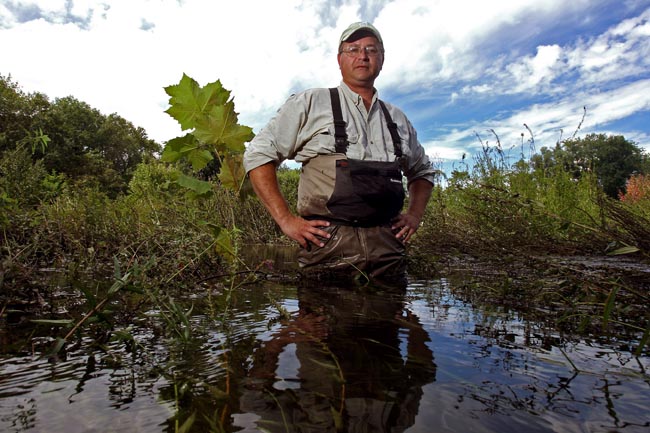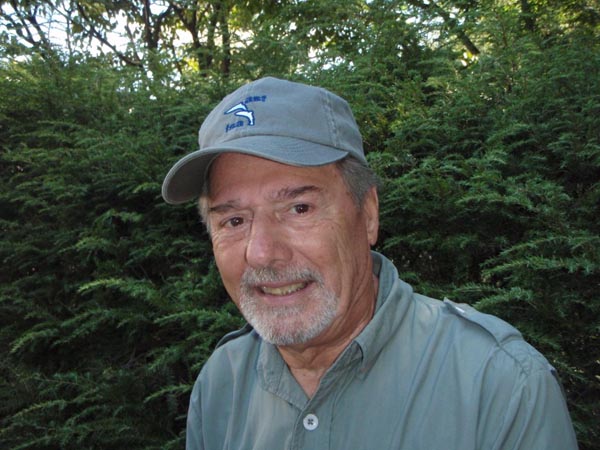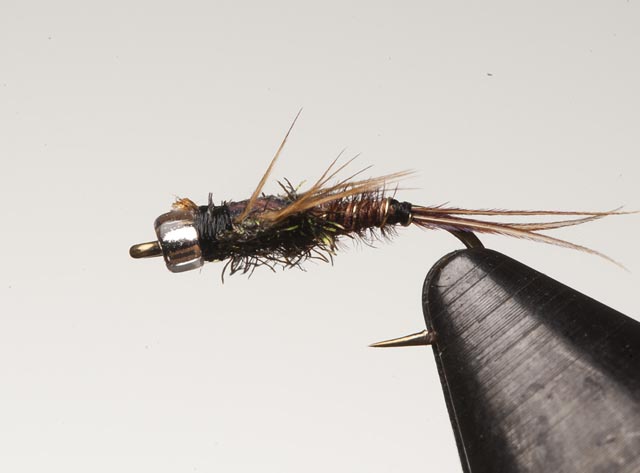


|

|
September 2016 |
|
News & EventsGeneral Meeting - Tuesday, September 13, 2016Brian Cowden

Brian Cowden – Co-Owner of Trout Scapes River Restoration LLC, Bozeman, MT. Brian and his partners Eric Werhand and Lance Bigelow formed Trout Scapes in 2016 after working together with another river restoration firm, Urbani Fisheries, LLC. Prior to that stint as head of sales and marketing, Brian spent seven years working for Trout Unlimited as the Coordinator for the Musconetcong Home Rivers Initiative in northwest New Jersey. His interest in conservation led Brian to become an active TU volunteer running Trout in the Classroom (TIC) program as state-wide coordinator. Later, Brian joined TU“s New Jersey state council as vice chair. After 20 years in corporate sales, Brian joined the TU Eastern Conservation staff in February 2008. While at Trout Unlimited, Brian worked to remove obsolete dams, restore degraded river channels, oversee riparian planting projects, and work on critical lands protection to benefit wild trout habitat while working closely with private and public landowners and non-profit organizations, local, state and federal agencies, as well as performing public outreach and education to protect and restore the Wild & Scenic Musconetcong River and its tributaries. Brian has won numerous awards including a national Youth Education Award from Trout Unlimited for his work on the Trout In the Classroom (TIC) program, New Jersey State Forestry Stewardship Award in 2012 for his forestry work to develop healthy early successional forest habitat, and the national President’s Coastal America Award for his work with partners to restore anadromous fish passage and habitat in the Delaware watershed. Tuesday, October 11, 2016Rob Paull and Ozzie Ozefovitch
“Point Mountain, Then and Now” is a presentation chronicling the restoration of the Point Mountain stretch of the Musconetcong River in New Jersey. Through the years, the river had become less friendly to trout surviving the seasons. Many areas were too shallow for trout to reside comfortably through the tough summer months and be around to tantalize us the following year. The efforts of CJTU and many others allowed a major restoration project to take place in 2015. The stream was reconfigured to include many deep pools, runs, boulders, widening, and bank stabilization. It now allows for holdover fish to comfortably reside and tempt our flies in the future. 
Rob Paull has been an avid fly fisherman, fly tyer, nature photographer, field recordist among numerous other hobbies since childhood. He is a life member of Trout Unlimited. He has traveled throughout the country fishing in Montana, Idaho, Colorado, New Mexico, Washington, and Alaska. He has given presentations on his trips to Alaska and the Snake River in Idaho. When he is outside of his Dermatology office, he can be found on a golf course, enjoying classical and jazz music, recording classical music for the Garden State Philharmonic and Livingston Symphony Orchestras, or enjoying a good pipe or cigar. 
Ozzie has spent considerable time volunteering with the Central Jersey Trout Unlimited chapter where he serves on the Board of Directors and is the coordinator for the Trout in the Classroom program. Over the years he has worked with the NJ Division of Fish and Wildlife by being involved in K-12 education programs, stream restoration projects and stream surveys. In the late 90’s Ozzie combined his love of trout with a lifelong interest in movie making. He has produced a series of underwater videos exploring how trout feed, spawn and behave in streams and rivers. Dvd trailers can be seen on www.underwateroz.com He presents his many video programs at the Fly Fishing Shows, Trout Unlimited Chapters, and other venues throughout the states. American Legion Hall
|
Richard Dooley
It is with great sorrow that I have to announce the unexpected passing of our chapter president Richard Dooley. Richard passed away suddenly, in his home, on June 27, 2016. Announcements were made on our Facebook page, but some of you may be getting the news for the first time since we do not publish newsletters during the summer months. Richard, or Rick as he was known by his friends, was a long time life member of Trout Unlimited. He was an active member of the board for close to two decades before taking the reigns as President in 2015. He had been an active member of CJTU from the day he and his father joined Trout Unlimited. Whether it was stream improvement work day, fly casting lessons, working the shows or teaching fly tying you could always count on Rick being there. Rick's three passions in life were his family, fly fishing and conservation. Rick was a good friend, together we traveled and fished all over this country. Our journeys took us from the rivers and streams of the northeast to north woods of Michigan to the wilderness areas of Montana, Wyoming and Idaho as well as the desert mountains of the southwest. Out of all the places he fished it was Montana that held a special place in Rick's heart. Rick was part of a small circle of close friends who make the pilgrimage out west each summer. Rick passed away a few days before leaving for our trip this year. Rick was 46 years old and is survived by his father Richard, his wife Sara and his daughter Maggie. He was loved by his family and friends, he will be greatly missed. Tight lines my friend... Bart Lombardo |
President’s LetterSeptember 2016It saddens me to have to write this month's President's Letter. By now most of you have learned of our Chapter President, Richard Dooley's unexpected passing. Rick was a close friend of many of us and he will be deeply missed. The summers are quiet for CJTU. We take a break from monthly meetings and most of us give the trout of New Jersey a well deserved rest. High temperatures and low waters put a lot of stress on cold water fish such as trout. This year we have seen more than our share of both. Hopefully cooler weather and more rain is right around the corner. There is a lot going on in the upcoming months. Central Jersey Trout Unlimited will be hosting a fly casting class at the Pequest Hatchery on Sunday, September 25th. The class starts at 10:00am and runs until 3:00pm. We will cover the basics of fly casting and then take the students down to the education pond to try out their newly learned skills on the huge trout swimming there. We provide all of the needed equipment and flies but feel free to bring your own gear if you have it. You can sign up for the class by calling the Pequest Hatchery at 908-637-4125 ext. 0. We have also started two new partnerships. The first is with Duke Farms in Hillsborough Township. On October 8th we will be conducting a course entitled Fly Tying 101 in conjunction with the staff of Duke Farms. The course will include a hands on stream walk to learn about the organisms swimming, clinging and crawling in the ecosystem. We will then we will return to the classroom to tie patterns to match these different insects. Attendees will leave the class with completed flies and materials to tie your own. The cost is $20.00 and you can sign up by visiting the program page at www.dukefarms.org The second partnership is with LL Bean in Freehold New Jersey. CJTU fly tiers will be on hand tying flies in the store on October 1 & 2 and October 15 & 16 between the hours of 11:00am and 5:00pm. This is the first of several programs we will be conducting with LL Bean. LL Bean is a great supporter of Trout Unlimited on both the national and local level. Our chapter has received many donations from them in the past and we are excited to be able establish a direct relationship with them. If your in the area stop by and say hello. We are looking for volunteers to assist with a stream improvement project on September 23rd. We will be working at Burnt Mills on the Lamington River near its confluence with the North Branch of the Raritan between the hours of 9:00am and 12:00pm. Our focus will be the removal of invasive plant species currently occupying the floodplain. If you interested in helping out drop us an email at info@cjtu and I will provide you with all the details. Bring a rod along as we plan on fishing after completing our work. Brian Cowden will be providing a presentation on "River Restorations: Repairing Ecological Functions of a River" at our September meeting. In addition to our normal bucket raffle, we will be giving away a box of flies at this meeting. If you walk through the door you'll be automatically entered in the giveaway. I'm pleased to announce that George Hryvniak is stepping up as interim president due to Richard Dooley's untimely passing. George is a long time member of TU and a past president of Central Jersey. I am very excited to make this announcement as I know George will provide great leadership for the chapter. I am looking forward to working with him.
Tight Lines |
Central Jersey GossipGeorge HryvniakSpecial Edition - I never knew TU was that involved with stopping the Tocks Island damEach month when I phone members from our membership list I never know who I might reach and be told some surprising story. Well among my calls this month, I phoned a gentleman by the name of George Nimmo. I had never heard his name before and was surprised at the conversation we had. George sent me a subsequent e-mail after we spoke that evening. The story is so special that I found a need to verify the things he told me. Since George Nimmo's TU activity started back in 1969, I felt the only member who may have known him was Dick Turse. Dick was a charter member of CJTU. I sent George Nimmo's e-mail on to Dick and asked him if he, in fact, knew George and if the information was accurate. This is a quote from Dick's reply to me, “Everything George Nimmo wrote you is completely true. He was a dynamo and, as far as I am concerned, he was the main force and guiding leader that stopped that Tocks Island dam. I was a good friend of George…” Well, I then realized I had a conversation with one of the most significant members in New Jersey Trout Unlimited's history and efforts. The scope of the proposed Tocks Island Dam was far reaching. For those of you unaware of it because of your age, I suggest you Google it. Now here is George Nimmo's story in his own words: George: Thanks very much for the call Sunday evening - good of you to do that. As I mentioned, my original membership (1969) was in the only existing chapter of TU at the time, the North Jersey Chapter. However, I was also a member of the East Jersey, Central Jersey, and Ken Lockwood Chapters (as well as the North Jersey Chapter) simultaneously, back in the early to mid 1970s. Also, as mentioned, I'm the only living honorary life member (to my knowledge) of the NJ State Council of TU. The other is the late Fred Burroughs, who passed away in January of 1996 - a good friend and fishing companion of nearly 30 years. But the Tocks Island Dam? We at the North Jersey Chapter heard about this early on, back in the late 1960s, and viewed it with great suspicion. When we learned more about the project, it became a cause and a mission, ultimately locating like-mined individuals in the Sierra Club, Lenni Lenape League and others. These folks were in process of forming a loose coalition to oppose the dam and to maintain the main stem of the Delaware River as a free-flowing waterway. There was no formal organization, at that time - just some various people with similar views and interests. However, with growing opposition, we decided to take the steps to formalize and to develop a 'mission statement.' Our collective representation in the Save the Delaware Coalition (as it became known) was, to my knowledge, the largest representative conservation organization ever formed, anywhere on earth, representing some 11.2 million members/people, and that's not a typo. Our struggle went through various measures and steps, including producing a 'White Paper,' Congressional testimony, speaking engagements ranging from local garden groups to Scouting troops and generally making ourselves visible and poking holes in the fabric of the powers that be and their interests in seeing the project through to completion. The battle was joined, and it went on from approximately 1970 to July of 1990, when the project was finally de-authorized on the 19th of July, 1990. We had prevailed over Congress, the Army Corps of engineers and the Delaware River Basin Commission, among others, including the Nuclear Energy Commission. Now, the Delaware River is the longest free-flowing river east of the Mississippi, and is now fully protected by wild and scenic designations, as it should be. My role in all of this? I was the National Representative for TU and the rep from the NJ State Council of TU. I was instrumental in bringing membership into the Save the Delaware Coalition, in the form of other conservation and interest groups(Wilderness Society, National Wildlife Federation, Appalachian Mountain Club, canoe and kayak clubs, Boy Scouts of America and many others, as well). My efforts brought in representation in excess of seven million members/people, over about three years of unending efforts. But, as we once said at the Save the Delaware Coalition, "We were in the business of putting ourselves out of business," and we were completely and utterly successful. These days, almost no one even knows who we were and what we did, and that's O.K. with me - nobody even knows our names. The only remnants of our efforts now lie in the decaying properties of the valley's former residents and the remains of some of the core drillings taken by the US Army Corps of Engineers (they're still there, to this day, if you know where to look - I have some photos of them somewhere, taken some years ago). There's so much more to this story that will never be known or told - many have passed on, but I've bored you long enough. Thanks again for the telephone call. Take care... George(Nimmo) Warren, NJ P.S. And yes, I did wet a line with the likes of Art Flick, Harry Darbee and Frank Mele, along with some of the 'old boys' from the Orvis Company (Bill Cairns, Dan Reed), Leon Chandler (Cortland Line Company - world champion fly caster), and the fellow who developed what's now called the Hare's Ear Caddis (Bill Dorato). The fly was originally called 'The Batten Kill Caddis.' Below is a recent article telling something about Frank Mele and his efforts in the Catskills, during the early 1970s: http://www.recordonline.com/article/20160313/ENTERTAINMENTLIFE/160319859
Until next month, Good Fishing, |
Fly of the MonthAn Updated and Expanded Fly of the Month ProgramOur Chapter has many excellent tiers who produce a wide variety of productive flies for use in fresh and salt waters. The sets of flies submitted to the Fly Swaps for the last three seasons confirm this. Yet, submitted flies have not been shared in our Fly of the Month feature in Mainsteam. So a contributor’s thoughts on a fly and specific tying instructions are just lost. We’d like to change this by having one fly submitted in previous Fly Swaps featured as the Fly of the Month. Further, we want not only to publish the description of the fly but to have the contributor tie the fly at the Chapter Meeting for that month. To launch this updated program, Bill Ninke has supplied the following writeup for the Mercury Pheasant Tail Nymph which he contributed to the 2016 Nymph Swap. He’ll be showing how he ties this nymph before and after the formal meeting and during the break. We thank Bill for his willingness to help launch this new program. Hopefully other submitters to the Swaps will be equally willing in the future. “Mercury Pheasant Tail Nymph ”Pattern originated by Pat Dorsey, this version tied by Bill Ninke Pat Dorsey (an author, guide, and tier from Colorado) is generally credited with creating and popularizing the “Mercury” series of nymph and midge patterns. Flies in this series all have a small silver lined clear glass bead at their head. This bead provides just enough weight to cause the fly to ride a few inches under the surface when tied on as a dropper to an indicator dry fly. It also gives the pattern a bit of flash to attract a trout’s attention. The fly works well as a shallow dropper early in the season when small nymphs and midges are around. It also works well as a dropper off a heavier nymph in a two fly deep system as the season progresses. Pat’s original dressing (in Tying and Fishing Tailwater Flies) uses four fibers for the tail and body and forms legs, two to a side, from the butt ends of the pheasant tail fibers. While his version certainly works, I feel the butt ends are too large and inflexible to give the pattern a natural look and action. Thus, I’ve chosen to form the legs from fibers from a hen saddle. Getting these fibers as balanced sets on each side of the fly and of the proper length is a bit of a fussy procedure. But, if you use, as I have, the procedure Tim Flagler shows in his video on tying the legs on the Copper John nymph, you’ll achieve a perfect result. Well, maybe the first few won’t look great. But practice always helps on any new procedure. Click here for the recipe! |